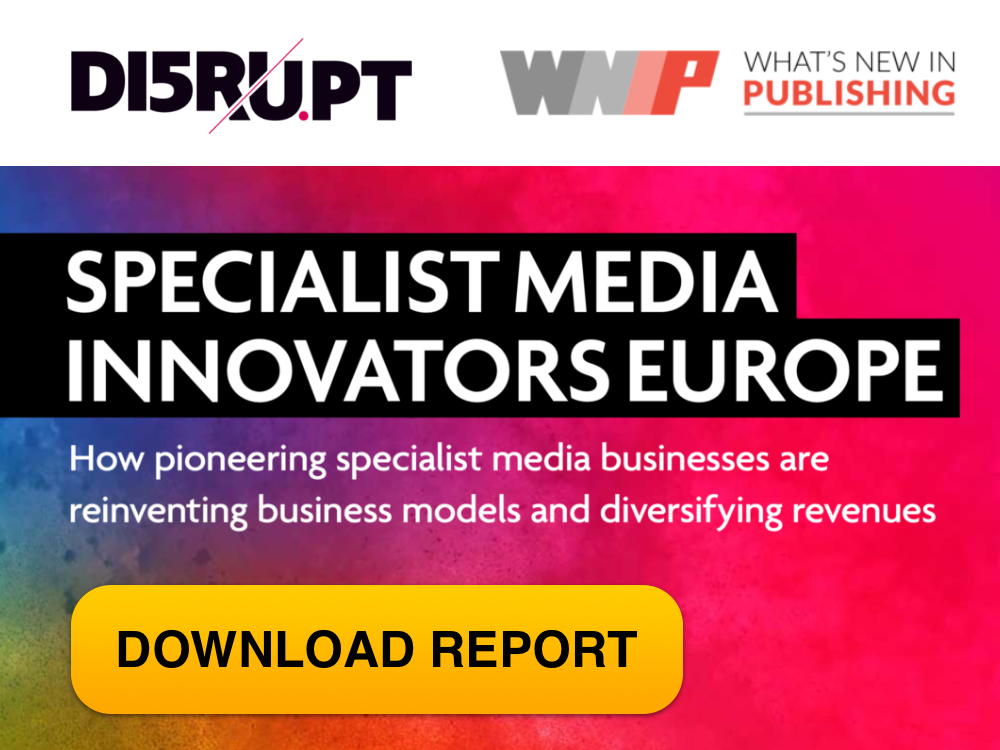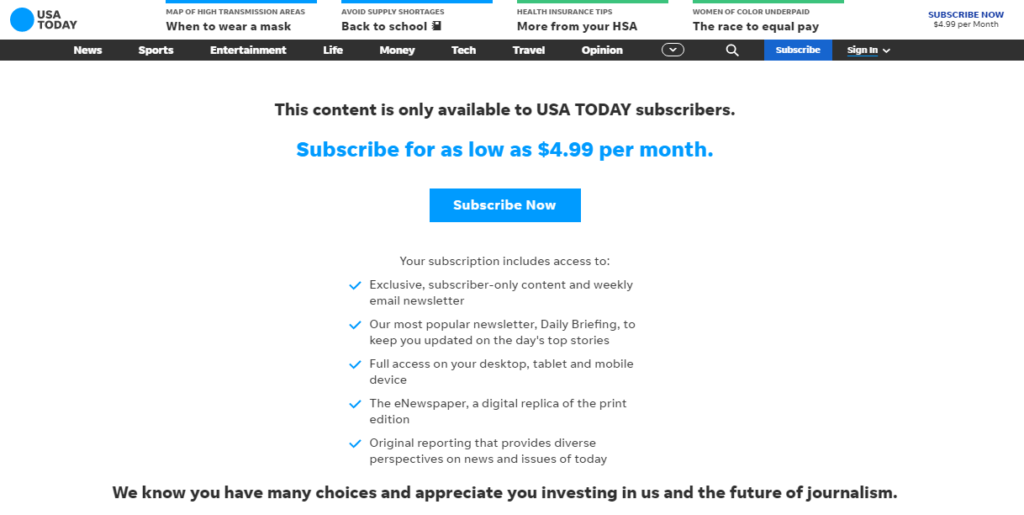|
Getting your Trinity Audio player ready...
|
This article is an excerpt from our special insight report, Paywalls for Publishers. This free-to-download report aims to help you formulate an effective paywall strategy via insights and examples that have worked well for other publishers. The guide also examines how you can leverage your first-party data and build a supportive organizational culture to boost your paywall strategy.
Soft paywalls allow readers to experience the quality of your content and may over time inspire them to sign up for a paid subscription. Research done by American Press Institute’s Media Insights Project found that 47% of new subscribers signup after running out of free articles on a site they like and respect.
Metered paywalls are the most popular form of soft paywalls. They let readers access a set number of articles for free before requiring them to pay. Wired allows readers to consume four articles a month for free before asking them to subscribe for unlimited access.
Getting your readers to register and log in with their emails to access free content is also important. It enables you to understand them better by monitoring their onsite behavior and you can make personalized content recommendations (on-site and via emails) based on their behavior. It will drive engagement and over time, increase their chances of subscribing.
GateHouse Media, which merged with Gannett, uses a “two-five meter,” in its publications. Readers can consume two articles for free before being asked to register themselves to unlock three more articles. The publisher has found that a registered user is 4x more likely to become a digital subscriber compared to an anonymous one.
“Too often, publishers view digital subscription through the lens of free visitors versus paid subscribers, but this neglects the value of free registered users,” writes Mary-Katharine Phillips, former Media Innovation Analyst, Twipe. “There is no greater indicator of a reader’s interest to pay than volunteering their email address.”
A metered paywall works best for well-known brands that produce a high volume of content, like The New York Times. “When done well,” says tech and media journalist Simon Owens, “a metered paywall allows publishers to generate reader revenue without forcing the outlet to take a negative hit to its web traffic. That way it can continue to monetize with ads.”
The metered model is less disruptive to casual visitors and can convert 5-10% of the most engaged readers into paying digital subscribers.
Michael Yeon, VP at paywall and subscription management platform, Admiral
Many set the meter too high and as a result, lose out on potential subscribers. The exact number of free stories depends on the reading behavior of each publisher’s audience.
“Publishers can test the number of articles offered to optimize subscription conversions for their audience,” adds Yeon. They need to “monitor the behavior of their most engaged users and set a meter limit which does not discourage casual visitors, but catches monthly regular readers.” Currently, publishers offer an average of 5 free articles per month, down from 13 in 2012.
Key Takeaway: You can consider opting for a metered paywall if you produce a high volume of content and are a well-known brand in your target market. In short, it allows readers to sample your content without hurting its value or ad revenues.
The other commonly used variations of soft paywalls include:
Freemium: Freemium models offer readers a mix of free and premium content, in which editorial teams often curate the articles that will appear behind a paywall. Some publishers find it better than metered paywalls which treat all content equally – a 500-word breaking news story is counted against the article limit, as well as an in-depth investigative piece.
Gating the more valuable pieces, which happens in the freemium model, makes better business sense. Most people subscribe to get access to distinctive journalism they can’t get anywhere else. The free content meanwhile, can help expose the brand to a larger audience and generate ad revenue as well.
Business Insider uses this approach with its editorial leadership team assessing whether a story goes behind the paywall or is made freely available. “Where I struggle the most with the metered approach,” Claudius Senst, former Head of Consumer Subscriptions at Business Insider, tells Owens, “is that if I read three amazing, in-depth journalistic pieces and then hit a fourth story that’s just a short snippet of an article, and on that story I hit the paywall, I always feel betrayed as a user. I feel like ‘why is it asking me to pay now?’”
A freemium paywall works best for brands with unique content, helping to highlight the valuable content you produce. However, “this model can also go wrong if the content chosen to be put behind the paywall is decided by gut feeling and not backed up by data,” suggests Phillips.
“It’s important to analyze which stories actually trigger subscription acquisitions and put those behind the paywall.”
Hybrid: Publishers using this approach combine different aspects of metered and freemium models. They may change users’ article limits based on their behavior, or offer exclusive content/products to subscribers (like newsletters, events, etc.)
Gannett, which publishes USA Today, uses a hybrid model across its publications. The publisher offers subscriber-only content to readers along with free articles. The newsroom decides what goes behind the paywall. “You don’t want to put things that are commodity content behind a paywall,” says Amalie Nash, SVP of Local News and Audience Development, USA Today Network, “because people aren’t going to subscribe and they’re not going to see the value in something like that.”
Around 10-20% of Gannet’s content is placed behind its “for subscribers” paywall. Sports commentary, local dining, and investigative projects perform well, with people subscribing directly off that content, Nash tells Local News Initiative. While all growth couldn’t be attributed to this model, it was one of the most successful ways the publisher’s subscriber base has grown in years, she adds.
French local newspaper Le Parisien doubled its digital subscribers last year using this model. A key element of its strategy included focusing on a hybrid of metered and paywalled content on its site. The newspaper used a standard metered paywall earlier. Over time it started adding premium articles for subscribers only.
The number of premium articles was steadily increased from 10 a day at the beginning of 2020, to 50 a day by the end of the year, Sophie Gourmelen, MD and Publisher, Le Parisien told WAN-IFRA. The strategy worked, as 90% of all new subscribers came via premium articles. The paper not only doubled its subscribers, but subscription revenues as well by raising digital subscription prices from 5 to 8, and then 10 euros a month.

Le Parisien analyzes reader data to identify the kinds of stories that convert casual readers into subscribers. Top converters include long reads, human interest stories, real estate, and local mobility topics, such as bicycling.
Some publishers also use leaky or porous paywalls, which allow users to access content beyond the set limits. For example, when they access content via social media and search engines or even by using the incognito mode in their browser.
Publishers may also occasionally lift paywalls from certain types of stories, like breaking news or stories related to public calamities. This was seen in the case of the Covid-19 crisis when many outlets made their pandemic-related coverage free.
By allowing conditional access to content beyond set limits you can let readers experience more of your content without reducing its value. It can also help you reach more (and possibly new) readers, coming through search and social media.
Timewall is yet another variation of soft paywall in which content is free for a certain amount of time, say an hour after publication, after which it is placed behind a paywall. The model helped Idaho-based local news publisher Boise Dev generate “tens of thousands in reader revenue,” according to its Founder and Editor, Don Day. Swedish publisher Mittmedia was able to increase subscriber conversions by 20% using this strategy.
“Using time can be a valuable part,” David Gosen, CRO, Piano, told Digiday, “but the overriding subscription strategy has to be reader-led.”
“Serving relevant content to the reader leads to better conversion rates. At its core, future success in the subscription business is unquestionably driven by the AI capabilities to process huge volumes of data to segment and target prospects to convert.”
David Gosen, CRO, Piano
Originally published in What’s New in Publishing earlier. While some of the data points may have evolved, the analysis and conclusion remain highly relevant.




